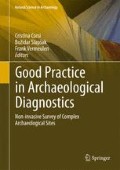Abstract
The London Charter for the Computer-Based Visualisation of Cultural Heritage (2.1) is a document written in 2009 by a pool of internationally renowned experts in digital technologies and virtual reality, which arose out of a recognition that the use of three-dimensional computer modelling in the historical, archaeological and broader cultural heritage domain, and particularly the rise of hyperrealism, risked introducing a dangerous lack of intellectual transparency, a lack which could critically compromise the actual and perceived validity of such research. The resonance of this initiative is such that it is already translated in ten other languages after the original version in English; the Charter has won formal endorsement from national and international bodies including adoption as an official guideline.
Here, the current main text of the London Charter is reproduced, and some aspects of it in greater detail are discussed, to give fuller explanations of the reasoning behind certain key points and to flesh out some of their implications for those seeking to implement it.
Access this chapter
Tax calculation will be finalised at checkout
Purchases are for personal use only
References
Anderson D, Delve J, Dobrerva M, Baker D, Billenness C, Konstantelos L (eds) (2012) The preservation of complex objects, vol. 1: visualisations and simulations. University of Portsmouth, Portsmouth
Baker D (2012) Defining paradata in heritage visualization. In: Bentkowska-Kafel A, Baker D, Denard H (eds) Paradata and transparency in virtual heritage. Ashgate, Farnham, pp 163–175
Beacham R, Denard H, Niccolucci F (2006) An introduction to the London Charter. In: Ioannides M, Arnold D, Niccolucci F, Mania K (eds) The e-volution of information communication and technology in cultural heritage: proceedings of VAST 2006. Archaeolingua, Budapest, pp 263–269
Bentkowska-Kafel A, Baker D, Denard H (eds) (2012) Paradata and transparency in virtual heritage. Ashgate, Farnham
Denard H (2005) At the foot of Pompey’s statue: reconceiving Rome’s Theatrum Lapideum. In: Bowman AK, Brady M (eds) Images and artefacts of the ancient world. Oxford University Press, Oxford, pp 69–76
Denard H (2012a) A new introduction to the London Charter. In: Bentkowska-Kafel A, Baker D, Denard H (eds) Paradata and transparency in virtual heritage. Ashgate, Farnham, pp 57–71
Denard H (2012b) Ecologies of research and performance: preservation challenges in the London Charter. In: Anderson D, Delve J, Dobrerva M, Baker D, Billenness C, Konstantelos L (eds) The preservation of complex objects, vol. 1: visualisations and simulations. University of Portsmouth, Portsmouth, pp 87–102
Frischer B, Niccolucci F, Ryan N, Barcelò JA (2002) From CVR to CVRO: the past, present, and future of cultural virtual reality. In: Franco Niccolucci (ed) Virtual archaeology: proceedings of the VAST Euroconference,Arezzo, 24–25 November 2000. Bar International Series 1075. Oxford: Archaeopress, pp 7–18
Goodrick G, Gillings M (2000) Constructs, simulations and hyperreal worlds: the role of virtual reality (VR) in archaeological research. In: Lock G, Brown K (eds) On the theory and practice of archaeological computing. Oxford University School of Archaeology, Oxford, pp 41–58
Hermon S, Niccolucci F (2006) A fuzzy logic approach to reliability in archaeological virtual reconstruction. In: Niccolucci F, Hermon S (eds) Beyond the artefact: digital interpretation of the past. Proceedings of CAA2004. Archaeolingua, Budapest, pp 11–17
International Forum of Virtual Archaeology (2010) Principles of Seville: international principles of virtual archaeology, final draft. http://www.arqueologiavirtual.com/carta/?page_id=437. Accessed 2 July 2013
Jablonka P, Kirchner S, Serangeli J (2003) Troia VR. A virtual reality model of Troy and the Troad. In: Doerr M, Sarris A (eds) The digital heritage of archaeology. Hellenic Ministry of Culture, Athens, pp 13–20
Mudge M (2012) Transparency for empirical data. In: Bentkowska-Kafel A, Baker D, Denard H (eds) Paradata and transparency in virtual heritage. Ashgate, Farnham, pp 203–242
Niccolucci, Franco (1999) Virtual reality in archaeology: a useful tool or a dreadful toy? In: Proceedings of the Medi@terra symposium, Athens, November 1999. 238ff. Athens
Pletinckx D (2012) How to make sustainable visualizations of the past: an EPOCH common infrastructure tool for interpretation management. In: Bentkowska-Kafel A, Baker D, Denard H (eds) Paradata and transparency in virtual heritage. Ashgate, Farnham, pp 203–242
Roberts JC, Nick S. Ryan (1997) Alternative archaeological representations within virtual worlds. In: Bowden R (ed) Proceedings of the 4th UK virtual reality specialist interest group conference, Brunel University, Uxbridge, Middlesex, November 1997, pp 179–188. http://www.cs.kent.ac.uk/people/staff/nsr/arch/vrsig97/vrsig.html. Accessed 2 July 2013
Roussou M, Drettakis G (2003) Photorealism and non-photorealism in virtual heritage representation. In: Arnold D, Chalmers A, Niccolucci F (eds) Proceedings of VAST2003, fourth international symposium on virtual reality, archaeology and intelligent cultural heritage. Eurographics, Aire-La-Ville, pp 51–60
Ryan N (1996) Computer-based visualization of the past: technical “realism” and historical credibility. In Main P, Higgins T, Lang J (eds) Imaging the past: electronic imaging and computer graphics in museums and Archaeology, British Museum occasional papers 114. The British Museum, London, pp 95–108
The London Charter for the Computer-based Visualisation of Cultural Heritage (2009) http://www.londoncharter.org. Accessed 2 July 2013
Zuk T, Carpendale S, Glanzaman WD (2003) Visualizing temporal uncertainty in 3D virtual reconstructions. In: Mudge M, Ryan N, Scopigno R (eds) Proceedings of VAST 2005, sixth international symposium on virtual reality, archaeology and cultural heritage. Eurographics, Aire-La-Ville, pp 99–106
Author information
Authors and Affiliations
Corresponding author
Editor information
Editors and Affiliations
Rights and permissions
Copyright information
© 2013 Springer International Publishing Switzerland
About this chapter
Cite this chapter
Denard, H. (2013). Implementing Best Practice in Cultural Heritage Visualisation: The London Charter. In: Corsi, C., Slapšak, B., Vermeulen, F. (eds) Good Practice in Archaeological Diagnostics. Natural Science in Archaeology. Springer, Cham. https://doi.org/10.1007/978-3-319-01784-6_15
Download citation
DOI: https://doi.org/10.1007/978-3-319-01784-6_15
Published:
Publisher Name: Springer, Cham
Print ISBN: 978-3-319-01783-9
Online ISBN: 978-3-319-01784-6
eBook Packages: Humanities, Social Sciences and LawSocial Sciences (R0)

